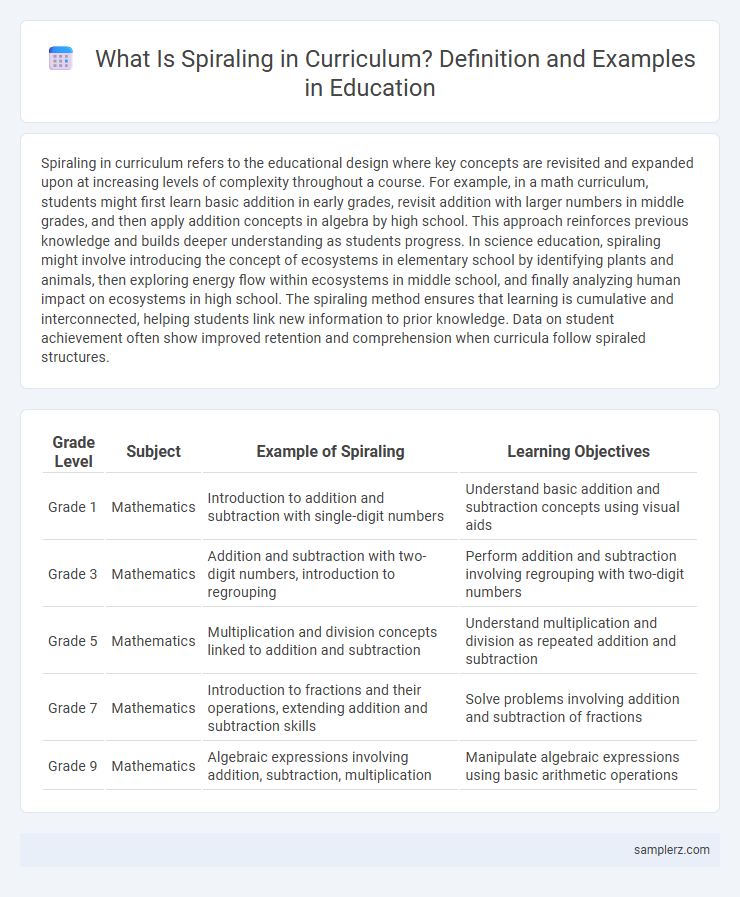Spiraling in curriculum refers to the educational design where key concepts are revisited and expanded upon at increasing levels of complexity throughout a course. For example, in a math curriculum, students might first learn basic addition in early grades, revisit addition with larger numbers in middle grades, and then apply addition concepts in algebra by high school. This approach reinforces previous knowledge and builds deeper understanding as students progress. In science education, spiraling might involve introducing the concept of ecosystems in elementary school by identifying plants and animals, then exploring energy flow within ecosystems in middle school, and finally analyzing human impact on ecosystems in high school. The spiraling method ensures that learning is cumulative and interconnected, helping students link new information to prior knowledge. Data on student achievement often show improved retention and comprehension when curricula follow spiraled structures.
Table of Comparison
| Grade Level | Subject | Example of Spiraling | Learning Objectives |
|---|---|---|---|
| Grade 1 | Mathematics | Introduction to addition and subtraction with single-digit numbers | Understand basic addition and subtraction concepts using visual aids |
| Grade 3 | Mathematics | Addition and subtraction with two-digit numbers, introduction to regrouping | Perform addition and subtraction involving regrouping with two-digit numbers |
| Grade 5 | Mathematics | Multiplication and division concepts linked to addition and subtraction | Understand multiplication and division as repeated addition and subtraction |
| Grade 7 | Mathematics | Introduction to fractions and their operations, extending addition and subtraction skills | Solve problems involving addition and subtraction of fractions |
| Grade 9 | Mathematics | Algebraic expressions involving addition, subtraction, multiplication | Manipulate algebraic expressions using basic arithmetic operations |
Understanding Spiraling in Curriculum Design
Spiraling in curriculum design involves revisiting key concepts at increasing levels of complexity to deepen student understanding over time. For example, a math curriculum might introduce basic fractions in early grades, then expand to equivalent fractions and operations with fractions in later years. This approach reinforces learning and builds connections, promoting long-term retention and mastery across subjects.
Key Principles of the Spiral Curriculum Approach
The Spiral Curriculum Approach revisits key concepts at increasing levels of complexity, reinforcing learning and promoting deeper understanding over time. It emphasizes gradual knowledge building, where each iteration connects new content with prior learning, facilitating long-term retention and mastery. This method supports differentiated instruction by allowing students to engage with material repeatedly, adapting to their evolving cognitive abilities.
Real-World Examples of Spiraling in Math Education
Spiraling in math education is exemplified by revisiting concepts such as fractions through increasingly complex real-world problems, like cooking measurements and budgeting exercises. Students initially learn the basics of fractions, then later apply these skills to scenarios involving recipe adjustments and financial literacy to deepen understanding. This approach strengthens retention and promotes critical thinking by connecting abstract math skills to everyday life applications.
How Science Curriculum Utilizes Spiraling Concepts
Science curricula utilize spiraling concepts by revisiting core topics such as ecosystems, matter, and energy across multiple grade levels with increasing complexity. For example, students initially explore basic plant life cycles in early grades, then expand to photosynthesis and ecological interactions in later grades, reinforcing understanding through layered knowledge. This structured repetition enhances mastery and connects prior learning to advanced scientific principles.
Spiraling in Language Arts: Progressive Skill Building
Spiraling in Language Arts curriculum involves revisiting key language skills such as vocabulary, grammar, and reading comprehension at increasing levels of complexity throughout the academic year. Students start with foundational concepts like basic sentence structure and gradually progress to analyzing complex texts and crafting well-supported arguments. This method ensures continuous reinforcement and deeper understanding, promoting long-term retention and skill mastery in language arts.
Integrating Spiraling Techniques in Social Studies
Integrating spiraling techniques in social studies involves revisiting key concepts such as government structures, historical events, and cultural diversity at increasing levels of complexity throughout the curriculum. This approach reinforces student understanding by gradually building on prior knowledge, enabling deeper connections between topics like civics, geography, and economics. Embedding spiraled lessons within social studies promotes critical thinking and long-term retention of essential themes across grade levels.
The Role of Assessment in a Spiral Curriculum
Assessment in a spiral curriculum plays a crucial role by continuously evaluating students' understanding as concepts are revisited at increasing levels of complexity. Formative assessments guide both instructors and learners in identifying knowledge gaps and tailoring instruction to reinforce and build on prior learning. This iterative feedback loop ensures mastery over time and supports deeper cognitive connections within the curriculum's structured progression.
Designing Lessons with Spiral Progression
Designing lessons with spiral progression involves revisiting key concepts such as fractions, algebra, or ecosystems at increasing levels of complexity throughout the curriculum. Each iteration reinforces prior knowledge while introducing new layers of understanding, enabling students to build a stronger cognitive framework. Effective spiral curriculum design promotes long-term retention and mastery by systematically scaffolding content over time.
Student Outcomes in Spiral vs. Linear Curriculum
Spiral curriculum promotes improved student outcomes by revisiting key concepts multiple times with increasing complexity, reinforcing long-term retention and deeper understanding. In contrast, linear curriculum often leads to superficial learning as topics are covered once without iterative reinforcement, risking knowledge decay. Research indicates that spiral learning structures enhance critical thinking and problem-solving skills by connecting prior knowledge with new information throughout the educational progression.
Best Practices for Implementing Spiraling in Schools
Effective spiraling in curriculum involves revisiting key concepts at increasing levels of complexity to reinforce learning and promote mastery over time. Best practices include integrating formative assessments to gauge student understanding, using interdisciplinary themes to connect knowledge, and providing differentiated instruction to meet diverse learner needs. Consistent collaboration among educators ensures alignment and smooth progression through spiraled content across grade levels.

example of spiraling in curriculum Infographic
 samplerz.com
samplerz.com